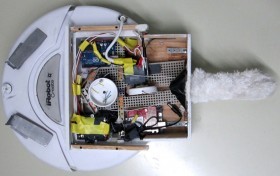« Back to Publications list
A Dog Tail for Utility Robots: Exploring Affective Properties of Tail Movement
Download Publication File
Abstract
We present a dog-tail interface for utility robots, as a means of communicating high-level robotic state through affect. This interface leverages people’s general knowledge of dogs and their tails (e.g., wagging means happy) to communicate robotic state in an easy to understand way. In this paper, we present the details of our tail construction, and the results of a study which explored a base case of people’s reactions to the tail: how various parameters of tail movements and configuration influence perception of the robot’s zoomorphized affective state. Our study indicated that people were able to interpret a range of affective states from various tail configurations and gestures, and in summary, we present a set of guidelines for mapping tail parameters to intended perceived affective robotic state.
Video
Download the A Dog Tail for Utility Robots: Exploring Affective Properties of Tail Movement video file.
Publisher Link
http://link.springer.com/chapter/10.1007/978-3-642-40480-1_27#
Citation
Ashish Singh, James E. Young. A Dog Tail for Utility Robots: Exploring Affective Properties of Tail Movement. In proceedings of the 14th IFIP TC 13 international conference on Human-Computer Interaction - INTERACT'13, 403-419.
Bibtext Entry
@inproceedings{Singh2013,
author = {Singh, Ashish and Young, James E.},
year = {2013},
location = {Cape Town, South Africa},
pages = {403-419.},
isbn={978-3-642-40479-5},
booktitle={Human-Computer Interaction – INTERACT 2013},
volume={8118},
series={Lecture Notes in Computer Science},
doi={10.1007/978-3-642-40480-1_27},
title={A Dog Tail for Utility Robots: Exploring Affective Properties of Tail Movement},
url={http://dx.doi.org/10.1007/978-3-642-40480-1_27},
publisher={Springer Berlin Heidelberg},
keywords={human-robot interaction; animal-inspired interfaces; affective computing},
pages={403-419}
}




